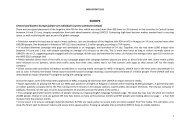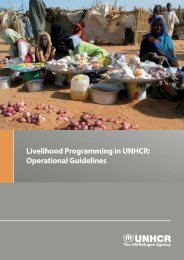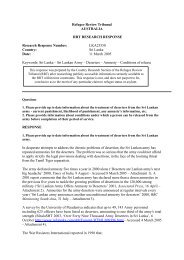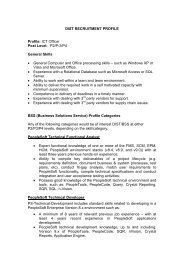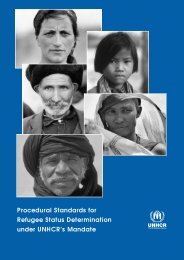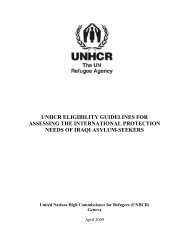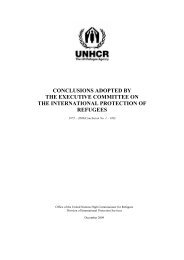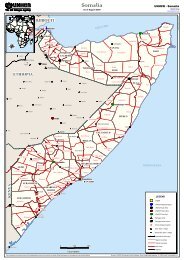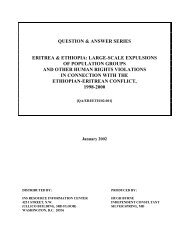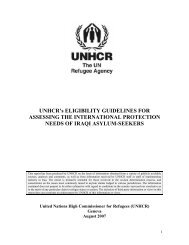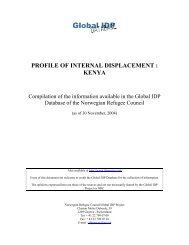The Human Rights situation of the Yezidi minority - UNHCR
The Human Rights situation of the Yezidi minority - UNHCR
The Human Rights situation of the Yezidi minority - UNHCR
Create successful ePaper yourself
Turn your PDF publications into a flip-book with our unique Google optimized e-Paper software.
specific law on national minorities, as envisaged by <strong>the</strong>ir membership <strong>of</strong> <strong>the</strong> Council <strong>of</strong><br />
Europe, and national minorities are <strong>the</strong>refore protected mainly under general nondiscrimination<br />
provisions scattered through a range <strong>of</strong> legislative acts. <strong>The</strong> non-resolution <strong>of</strong><br />
secessionist conflict and <strong>the</strong> emphasis on ethnic majority nation-building have impeded <strong>the</strong><br />
elaboration <strong>of</strong> comprehensive <strong>minority</strong> rights frameworks, although in all three republics it is<br />
usually <strong>the</strong> absence <strong>of</strong> resources that is used to explain inertia in this field.<br />
4.1 National Minority <strong>Rights</strong> in Armenia<br />
<strong>The</strong> issue <strong>of</strong> national minorities in Armenia in recent history has very much taken second<br />
place after <strong>the</strong> issue <strong>of</strong> Armenian national minorities in neighbouring states, first and<br />
foremost Azerbaijan. Armenia was always <strong>the</strong> most ethnically homogeneous <strong>of</strong> <strong>the</strong> Soviet<br />
republics and by <strong>the</strong> end <strong>of</strong> <strong>the</strong> Soviet period <strong>the</strong> only sizeable <strong>minority</strong> in Armenia was <strong>the</strong><br />
Azerbaijani population. This population, along with Armenia’s Muslim Kurds, was expelled<br />
during <strong>the</strong> process <strong>of</strong> mutual expulsions between Armenia and Azerbaijan <strong>of</strong> each o<strong>the</strong>r’s<br />
ethnic populations following <strong>the</strong> onset <strong>of</strong> conflict in Nagorny Karabakh, an autonomous<br />
region <strong>of</strong> Soviet Azerbaijan populated by a local Armenian majority. <strong>The</strong> arrival <strong>of</strong> over<br />
300,000 ethnic Armenian refugees from Azerbaijan contributed to <strong>the</strong> consolidation <strong>of</strong> a<br />
near-total ethnic Armenian majority in post-conflict Armenia. <strong>The</strong> 2002 census recorded 97.7<br />
per cent <strong>of</strong> <strong>the</strong> total population <strong>of</strong> <strong>the</strong> republic as being ethnic Armenian. Armenia’s<br />
minorities are, fur<strong>the</strong>rmore, dispersed and none constitute local majorities in any given<br />
administrative unit. This <strong>situation</strong> accounts for <strong>the</strong> low prominence <strong>of</strong> <strong>minority</strong> rights as an<br />
issue in Armenia.<br />
Although avoiding <strong>the</strong> image <strong>of</strong> a state with significant human rights problems, Armenia’s<br />
human rights record since independence is patchy. Although parts <strong>of</strong> <strong>the</strong> Armenian economy<br />
have flourished despite closed borders with Turkey and Azerbaijan, pervasive corruption,<br />
collusion between business and political elites, flawed elections and <strong>the</strong> uncertainty<br />
associated with <strong>the</strong> non-resolution <strong>of</strong> <strong>the</strong> Nagorny Karabakh conflict have compromised<br />
progress in forming democratic institutions. <strong>The</strong> fragility <strong>of</strong> this progress has been<br />
demonstrated on several occasions, such as <strong>the</strong> 27 October 1999 shootings in <strong>the</strong> National<br />
Assembly and <strong>the</strong> March 2008 unrest, in which eight people died, following a disputed result<br />
in February’s presidential election.<br />
Following <strong>the</strong> chaotic years <strong>of</strong> <strong>the</strong> early 1990s serious attention began to be paid to <strong>the</strong> issue<br />
<strong>of</strong> national minorities in late 1990s. Although a number <strong>of</strong> rights are enshrined in <strong>the</strong><br />
Constitution and o<strong>the</strong>r domestic laws, progress in establishing concrete laws addressing<br />
<strong>minority</strong> rights has been slow.<br />
4.1.1 <strong>Human</strong> and Minority <strong>Rights</strong> Instruments<br />
Armenia is a State party to major international human rights instruments, including <strong>the</strong><br />
International Covenant on Civil and Political <strong>Rights</strong> (ICCPR), <strong>the</strong> International Covenant on<br />
Economic, Social and Cultural <strong>Rights</strong> (ICESCR), <strong>the</strong> European Convention on <strong>Human</strong> <strong>Rights</strong><br />
(ECHR), <strong>the</strong> Framework Convention for <strong>the</strong> Protection <strong>of</strong> National Minorities (FCNM), <strong>the</strong><br />
International Convention on <strong>the</strong> Elimination <strong>of</strong> All Forms <strong>of</strong> Racial Discrimination (CERD),<br />
<strong>the</strong> European Charter for Regional or Minority Languages and <strong>the</strong> (Revised) European Social<br />
Charter.<br />
Article 14 <strong>of</strong> <strong>the</strong> Armenian Constitution prohibits any discrimination on grounds <strong>of</strong> “race,<br />
colour, ethnic origin…, language, religion or belief, or…membership <strong>of</strong> a national <strong>minority</strong>”.<br />
Article 26 provides for <strong>the</strong> freedom <strong>of</strong> conscience or belief and Article 41 confers <strong>the</strong> right to<br />
14




